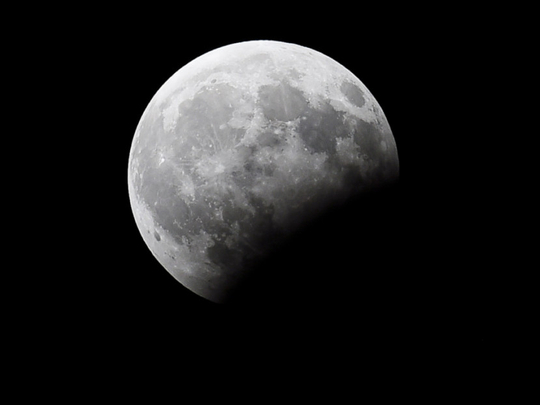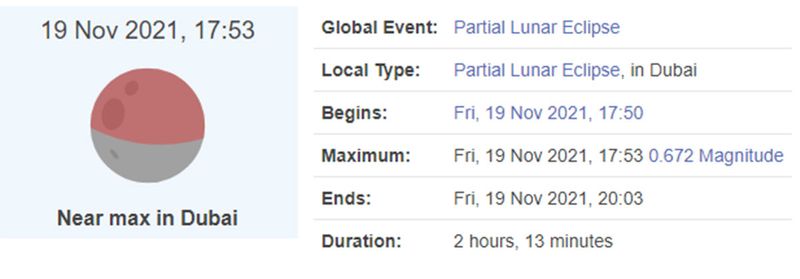
The Beaver Moon lunar eclipse, the longest in nearly 580 years, will be visible across North America, South America, eastern Asia, Australia and the Pacific region.
It will be the second lunar eclipse of 2021 and, in some ways, will be similar to the last one on May 26.
Though it's technically not a total lunar eclipse, it's about as close as one can get to totality without actually being there. At peak, 97 per cent of the moon will be covered by the umbra, or the darkest part of Earth's shadow. Only a sliver on the bottom left of the moon will remain faintly illuminated.
Will the eclipse be visible in the UAE?
According to Time and date website, the partial eclipse in Dubai will start at 5:50pm and end at 8:03pm on November 19, 2021. The duration of the eclipse will be 2 hours, 13 minutes and its peak will last 3 hours, 28 minutes and 23 seconds in the UAE.

However, Dr Hasan Al Hariri, CEO of Dubai Astronomy Group, said that the partial lunar eclipse will not be visible from the UAE.
“The eclipse will be visible from the centre of the pacific ocean, both the Americas, the eastern countries in Asia up to the western coast of Africa and Europe. This eclipse will be partial and people in the UAE will not be able to see it,” he said.
The last time a partial lunar eclipse of such length occurred was on February 18, 1440, and the next time a similar phenomenon can be witnessed will be on February 8, 2669, an Indian astrophysicist at M P Birla Planetarium Debipro sad Duari said. The maximum partial eclipse will be visible at 2.34 pm as 97 per cent of the moon will be covered by the Earth's shadow, he said.
The last time a partial lunar eclipse of such length occurred was on February 18, 1440, and the next time a similar phenomenon can be witnessed will be on February 8, 2669, an Indian astrophysicist at M P Birla Planetarium Debipro sad Duari said. The maximum partial eclipse will be visible at 2.34 pm as 97 per cent of the moon will be covered by the Earth's shadow, he said.
A striking element of the eclipse will be its duration - 3 hours, 28 minutes, and 24 seconds, according to Space.com, which it says makes it the longest partial eclipse in 580 years.
Beaver moon
At the time of the eclipse, the moon will be full. Some refer to the November full moon as the "beaver moon," a name assigned by Native Americans when beavers were particularly active in preparation for winter and it was time to set traps, according to Nasa. The November full moon is also sometimes called the frost, frosty or snow moon for the wintry conditions beginning at this time of year, Nasa writes.
Why does the moon appear red in some eclipses?
The moon is likely to appear blood-red in colour, which happens when the red beams of the sunlight pass through the Earth's atmosphere and get least deflected and fall on the moon.
A moon, once eclipsed, is also sometimes called a "blood moon" because of its reddish or rusty tone.
The eclipse will begin when many are asleep along the East Coast, but those residing on the West Coast don't need to be night dwellers to take in the best parts of the show.
When is the next lunar eclipse?
Lunar eclipses occur when the Earth intercedes between the sun and the moon. We're used to seeing the full moon illuminated by light arriving directly from the sun, but when the Earth blocks that light, a shadow sweeps across the lunar surface.
During total and near-total lunar eclipses, most of the moon's face is occupied by that shadow, but some sunlight passing through Earth's atmosphere can become tinged red and bathe the moon in an eerie amber hue.
Lunar eclipses are much more widely visible than solar eclipses and can be seen anywhere on the night side of Earth. The last lunar eclipse was on July 27, 2018. The next lunar eclipse will be on May 16, 2022. The next lunar eclipse to be visible from India will be on November 8, 2022.
When is the next solar eclipse?
Total solar eclipses are much more difficult to witness and may have a path of totality only a few miles wide. Both usually occur within a couple weeks of one another; a total solar eclipse looms on Dec. 4, but only those in the Southern Ocean or Antarctica will get to enjoy totality. For us, the lunar eclipse is a consolation prize.
Unlike with solar eclipses, no special glasses are required for viewing a lunar eclipse. You're simply looking at sunlight reflected off the moon, rather than staring directly at the sun. The former is OK. The latter is a no-no.
The last total lunar eclipse visible from the United States occurred May 26, and another one is in the cards for May 16, 2022. As for rare and dramatic total solar eclipse, the last occurred on August 21, 2017; the next is set for April 8, 2024.









